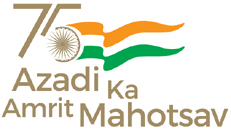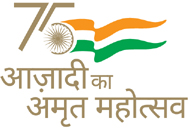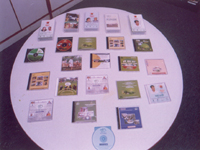
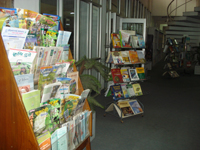
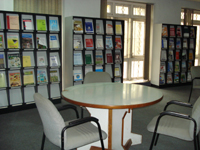
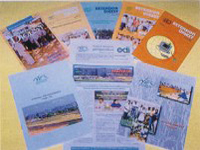
Videos/CD-ROMs
Success stories of Agripreneurs; Agriclinics and Agribusiness Centres Scheme, 2003
Successful initiatives by Agripreneurs trained under the Agriclinics and Agribusiness Centres Scheme
Agriculture to Agripreneurship: success stories of Agripreneurs, 2002
Documents successful initiatives by Agripreneurs
Vijay Gaatha of Agripreneurs, 2002
Documents 24 success stories of agripreneurs with 40 different types of projects
Gurukuls of Agripreneurship Development: a profile, 2002
Profiles 26 training organizations across the country involved in imparting training under the Agriclinics and Agribusiness Centres scheme
Evaluation of Participatory Adaptive Research Project by J.P. Singh, 2002
Examines the impact of the Participatory Adaptive Research Project (PAR) on the economy of the tribal farmers from whom it is meant.findings reveal the knowledge and attitudes of the farmers besides agro-economic changes due to the implementation of the project.
Agriculture Marketing: Interventions & Innovations by K.H.Vedini, 2001
Presents a collection of 41 papers contributed during an International convention on Agricultural Marketing held at MANAGE. Focus was on Institutional framework, pricing management, policies for agricultural marketing I the context of globalization, planning and management of Agricultural Marketing.
Private Extension: Indian Experiences by P.Chandrashekara, 2001
Documents Indian experiences in Private extension and also provides directions to beginners in private extension specially agripreneurs who wish to go back to villages and try out these innovations. Gives an overall view of private extension experiences in India, through agribusiness companies, Farmers organizations and farmers cooperatives, mass media, non-governmental organizations, linkages, experiences and lessons. Policy makers, academicians, practitioners especially agri-preneurs and agri-business companies, farmers and other sakeholders in private extension would find this useful.
Private Extension in India ; Myths, Realities, Apprehensions and Approaches by P.Chandra Shekara, 2001
Covers 16 papers presented during the first National seminar on Private Extension held at MANAGE in July 2000. Answers questions like: What is private extension? Who are the players? What are their approaches? What are the advantages and disadvantages of private extension? What kind of encouragement is needed to make Private Extension effective?
Economic Evaluation of Participatory Adaptive Research Project by J.P.Singh and M.A.Kareem 2001
The tribals are a downtrodden lot living in sheer destitution and shying from the modern civilisation. Despite several efforts made by the developmental agencies from time to time not much improvement has been found in the overall standard of living. The situation on the agricultural front was far more alarming with hand to mouth existence, low or no marketable surplus and very poor bargaining power. MANAGE has been identified as the agency to take up the Participatory Adaptive Research Project (PAR). The activities have been focussed to gain ground on the improvement of the income through the interventions on the technology front not only for agriculture but also in the livestock component as well as natural resource management involving both range management and the agro-forestry management the present investigation was undertaken to study the impact of the PAR project on the tribal farmers. The study would be helpful to researchers and decision makers in understanding the complex interaction of ecological, economic and demographic attributes arising out of the PAR programme.
Disbursement Procedure for World Funded Projects (A Guide to Project Implementing Agencies), by T.Raghavendran. MANAGE-NATP series 5, 2001
The book sets forth in detail the various processes involved in the disbursement of Loan funds from World Bank, beginning from the stage of expenditure incurred for the Project activities to the stage of reimbursement to the project from the Loans funds sanctioned by I.D.A (International Development Association) and IBRD (International Bank for Reconstruction and Development)
Socio Economic Dynamics and Development Strategy for Participatory Adaptive Research Project (PAR) by J.P.Singh, 2000
The Participatory Adaptive Research Project of the Andhra Pradesh Tribal Welfare department aims to find out ways and means to develop appropriate technologies for the complex and diversified systems for agriculture in the tribal areas of Andhra Pradesh. This document deals with the socio-economic status of tribal households in three centers viz. Bhadrachalam, Rampachodavaram and Utnoor, which will serve as baseline information of the project area at the time of impact evaluation. Various performance indicators identified for the purpose have been included in the report. An attempt is made to focus on the possible interventions that can be made to give some benefit to the tribal community in the short term. Also gives the scope for long term planning.
Floriculture :from Theory to Practice (The Netherlands Experience) by K.H.Vedini, 2000
This book presents a detailed understanding of the management of floral industry in Netherlands mainly emphasizing on pre-production market linkages and post-production market linkages, which broadly includes raw material industry and the product market. The present study explores the management aspects of the Netherlands floral industry emphasizing on the auction platform, which is unique to the study area.It focuses on three important aspects in general of the Dutch floral industry .Firstly it explores the production and trade structure of the study area, secondly the distribution pattern and networks and thirdly the environmental issues. This gives an understanding that the environmental concern is not only limited to health but also gaining importance in the ornamental sector.
Economic Evaluation of Manchal Watershed by.J.P.Singh, 2000
This is a case study of Bandelmur Watershed Development project. Focuses on the socio-economic characteristics of the households in the project area, studies the impact of watershed development programme on land use, cropping pattern, productivity and production in the project area, impact on income and employment and suggests suitable policy measures for scientific management of watersheds.
Management Issues in Rainfed Agriculture in India by K.H.Vedini, 2000
The book emphasizes the importance of dryland to meet the needs of the future. It is a comprehensive representation of the papers presented at the National Symposium conducted on Rainfed Agriculture at MANAGE during 7-9, June, 2000. This book is a synthesis of twenty papers representing the original research findings on various aspects of rainfed farming and its management. A few are concept papers trying to project some of the issues associate with prevailing scenario in rainfed economy.
Israel’s Agriculture (Achievement through innovation and Technology) by.J.P.Singh, P.Chandrasekhar,.TDS.Kumar and Lakshmi Murthy 2000
Procurement guidelines under National Agricultural Technology Project. MANAGE-NATP series 4, 2000
World Bank Guidelines regarding procurement, selection of consultants and other documents. Strategic Research and Extension Plan MANAGE-NATP series 3, 1999
Covers the what, why and how of strategic planning.
Agricultural Technology Management Agency MANAGE-NATP series 2, 1999.
NATP envisages testing of innovative institutional arrangements for delivery of extension services from the district to the village level. The concept of ATMA has been introduced as an autonomous organization providing a flexible working environment with an objective of integrating efforts of research, extension and all other stakeholders at the district level to support the farmers needs and interests through an integrated approach of strategic plan. Focuses on the concept of ATMA and its functioning.
Technical Manual on Watershed Management (Series (II) Resource,(III)Arable Cropping Systems, (IV) Non-Arable Cropping Systems, (V) Non-farming Systems & Watershed in Retrospect Conservation), 1999 J. Venkateswarulu
This manual enlists technologies relevant to different agro-climatic regions in India. Focus is on people friendly, low cost technologies, which are simple and easy to operate and maintain and are based on local materials and indigenous knowledge. The manual is divided into five parts dealing with Resource Inventorization, Resource Conservation, Arable Cropping Systems, Non Arable farming Systems and Watershed in retrospect.
Trainers' Training manual for Participatory Management on Watershed, 1999 G.R.Desai and S.K.Arora
The Trainer's manual works out the training curriculum for capacity building of the project implementation agencies. The manual is based on four modules dealing with (a) Common Guidelines and technical issues, (b) Participatory Rural appraisal and Community Organisations, (c) general management and project management skills and (d) Administration and Accounts matters.
Common Principles for Watershed Development, 1999
Manual on Monitoring and Evaluation of Watershed Development Hyderabad, MANAGE and NIRD, 1999
Innovations in Technology Dissemination of NATP. MANAGE-NATP series 1, 1998
MANAGE has a key role to play in the Innovations in Technology Dissemination (ITD) component of the National Agricultural Technology Proejct operating in 28 districts of 7 states in the country. Introduces the ITD component.
Training for Agriculture Development, by N.G.P. Rao, N.Perumal, S.L.Ghosal, 1997
This is a study (commissioned by Govt. of India) of the existing training infrastructure and programmes in the field of agricultural extension. The study team looks at the emerging scenario of agricultural development in the context of macro-economic policy and changing roles of agricultural research, extension and training institutions. It projects likely changes in the roles and responsibilities of various extension functionaries in the years to come, identifies training needs for the revised roles and the manner in which those needs should be met by the training infrastructure. Focuses on training institutions and programmes to meet future requirements and on the necessity of building effective training institutions as learning organizations. A three-tier system with backward and forward linkages to meet training needs is suggested which comprises of (I) SAU/NARP-ICAR/ATC for subject matter and programme content, (II) MANAGE/STI for planning, information processing and management, (III) GSTC/KVK/FTC for oper;ational and implementation skills at the grassroots level
Farmers' Participation in Agriculture Research and Extension Systems by K.C.John, C.S.Rajan, D.K.Sharma, Charanjit Singh, S.K.Arora, 1997
The study reviews the existing structure of agricultural extension and research and their operations in different ecological zones, proposes options for improving farmer participation in research and extension and suggests measures to improve quality management and cost effectiveness. It explores issues like reorganisation of institutional processes to make them flexible and responsive, approaches and methods that encourage functional participation vis-à-vis empowerment of farmer organisations and the need to embed the reforms into extension and research systems management. The recommendations attempt to define a conceptual framework that sketches strategic options most likely to make extension and research systems farmer participatory and client accountable. Considering the diverse agricultural situations, six models have been proposed for research and extension linkages in these six situations which include Assured rainfall and irrigated areas with normal food crops; high value commercial agriculture regions; rainfed crop based farming system; pastoral based farming systems in semi-arid and arid zones; rainfed horticulture based farming systems of the hilly regions and rainfed aquaculture based farming systems of the coastal regions.
Fertiliser and product Guide, 1997
It was observed that fertilizer recommendations prescribed were general (blanket) recommendations assuming N, P, K status of soil to be medium without taking into account the individual field fertility levels. Research indicated that yields obtained through generalised recommendations could be obtained with lower levels o fertilisers when applied on soil-test-crop-response basis, which would be more balanced, efficient and profitable. This indicated a need to fine tune dosage recommendations on the basis of soil tests, source and availability of water and the type and duration of different varieties of a crop. Thus a ready reckoner was compiled on fertilizer requirement of crops under various soil-crop variety-moisture-regime situations in terms of nutrients as well as products. This is intended to be used as a training manual and as a guidebook to extension workers, scientists and farmers for calculating fertiliser nutrient and product requirement for various crops under different situations. Crops covered include rice, potato, groundnut, sunflower, tobacco, soybean, rapeseed and mustard, chickpea, pigeon pea, sugarcane, pearl millet, cotton, maize, jowar and wheat. The whole information is presented in the form of graphs, charts and tables to make it easy to identify solutions to specific requirements. The Guide is targeted at farm advisory staff, extension workers, field officers of fertiliser industry and policy makers.




